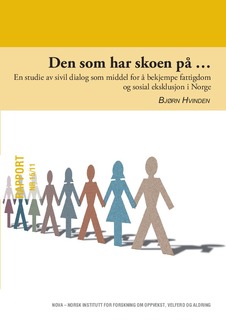Den som har skoen på...
Abstract
The topic of this report is a collaborative governance arrangement between the Norwegian government and organisations of economically and social disadvantaged persons. The arrangement has been operative since the spring of 2008 and involves the following elements: • A Contact Committee of representatives of the government and organisations of economically and social disadvantaged persons, convening two–three times per year to discuss measures for combating poverty and social exclusion in Norway • A Collaborative Forum established to enable spokespersons of ten to twelve organisations to strengthen their competence, clarify and prioritise joint demands and policy proposals to be presented to Ministers at the next Contact Committee meeting. • The Battery, a centre for supporting self-organisation and self-help efforts (under the Church Street Mission), in the role as secretariat, facilitator and intermediary in relation to the Ministries • Provision of financial support; the government has granted funds for the operation of to the Battery for its work vis-ö -vis the Contact Committee and the Collaborative Forum and for establishing new local Batteries across Norway, and for basic grants and project support for organisations of economically and social disadvantaged persons. Even if new and still under development, this model of collaborative governance and open and inclusive policy making has attracted attention internationally, for instance from the European Commission and the OECD. The international interest has centred on the model’s emphasis on facilitating capacity building and joint policy articulation among underrepresented groups, providing new resources these groups and the role of the Battery as facilitator and intermediary. Arguably the combination of these traits makes the Norwegian unique in a comparative context. This report takes stock of the experiences and achievements of almost three years of operation. On the basis of documentary analysis and a series of long semi-structured interview with key informants the study examines to what extent the model is on the right track to meet the stated objectives and the stakeholders’ expectations. The main findings of the study are: • The involved parties – the Battery and the organisations – have to considerable extent succeeded in making the Collaborative Forum an arena for capacity building and joint policy articulation, but the organisations’ heterogeneity in terms of profile, focus, organisational philosophy and approach has been a major challenge in their efforts to agree on truly joint proposals and clear priorities for demands vis-ö -vis the Ministers. Especially some organisations have tended to compete against each other about getting “their” cause and demands to be at the fore of the discussions. As a pragmatic solution to this competition, the Collaborative Forum has tended to propose a number of diverse issues to be included in the agenda of each Contact Committee meeting and allow some issues to be taken up at several successive meetings. Consequently, there has been relatively low renewal of issues over time and issues like for instance child poverty and the education of survivors of child protection have been given relatively scant attention. • Similarly, the Collaborative Forum and Battery had made some progress in promoting capacity building among the organisations of economically and socially disadvantaged persons but there was clearly a scope for further development, for instance in clarifying the target group for different capacity building events and in using the heterogeneity of the organisations as a potential source for competence transfer and mutual learning between the organisations. • While the availability of new funds for joint initiatives, actions and projects had stimulated more collaboration between the organisations involved in the model, the full potential for such joint ventures had not been exhausted. Factors contributing to the underuse of this opportunity were again the heterogeneity of the organisations, and the participating organisations’ uneven access to resources for basic organisational activities. • Overall the spokespersons of the organisations clearly stated that it had been important and valuable for them to be involved in the model, especially to be included among the representatives attending the Contact Committee meetings. In particular the spokespersons emphasised the improved possibilities for voice (or ‘representation’ in the sense spelled out by Nancy Fraser 2008) in relation to the experiences, needs and demands of people at the margin of Norwegian society. Next the spokespersons appreciated the increased visibility and acknowledgement of the organisations’ objectives, activities, competence and abilities (or ‘recognition’ in Fraser’s sense). The organisations were, however, more reserved or critical about the amount of tangible results of the participation, in the meaning of genuinely new and better public politics and provision (or achievements of ‘redistribution’ in Fraser’s sense). Although most of the spokespersons referred to some improvements in public policy, they regarded these more as adjustments and amendments than reforms indicating a new direction of public policy. Spokespersons also criticised the Ministers and Civil Servants for giving delayed and limited feedback on the issues and proposals that the organisations had raised in the Contact Committee meetings. The report discusses several factors that may account for this dissatisfaction on the part of the organisations and present a number of suggestions and recommendations for how the Ministers and Civil Servants could become more accountable, as perceived by the spokespersons of the organisations. Rapporten analyserer et uvanlig middel for å bekjempe fattigdom i Norge: Siden våren 2008 har representanter for regjeringen og om lag ti organisasjoner av økonomisk og sosialt utsatte diskutert tiltak mot fattigdom i et Kontaktutvalg. Organisasjonenes representanter har møtt jevnlig i et Samarbeidsforum for å styrke sin kompetanse og diskutere seg fram til felles forslag og prioriteringer overfor politikerne. Selvhjelpssenteret Batteriet (under Kirkens Bymisjon) har vært sekretariat. Denne modellen for sivil dialog har vakt internasjonal oppmerksomhet, men er ikke godt kjent i Norge. Rapporten gjør rede for erfaringene med modellen så langt, bygd på intervjuer og foreliggende dokumenter, og presenterer en rekke forslag for å gi modellen større gjennomslagskraft.
